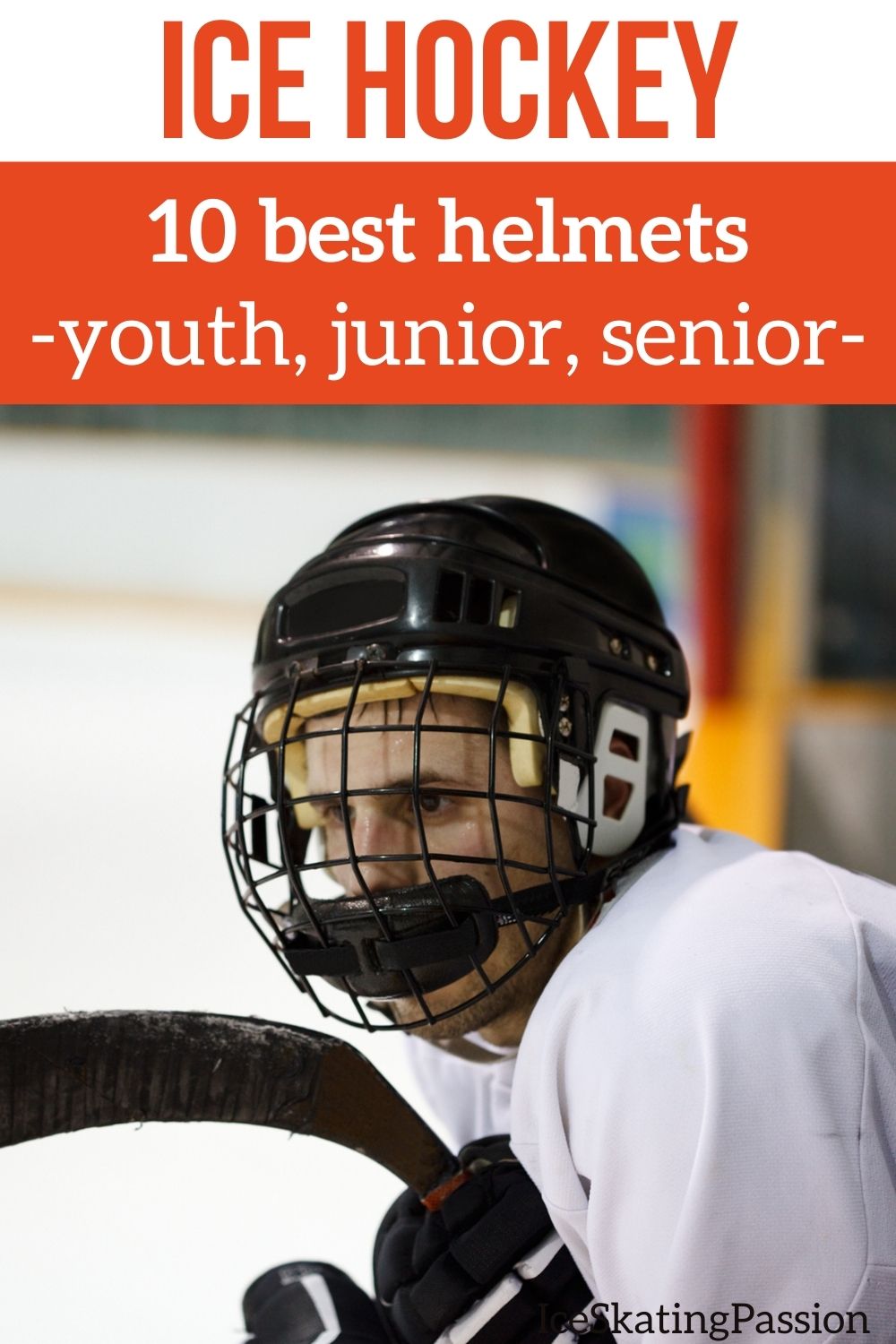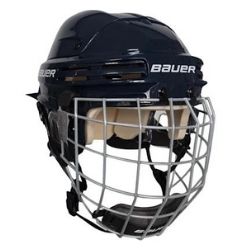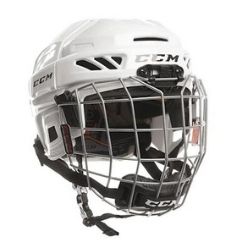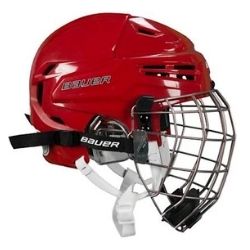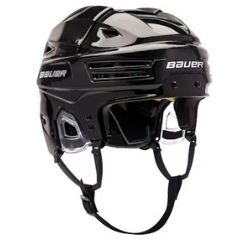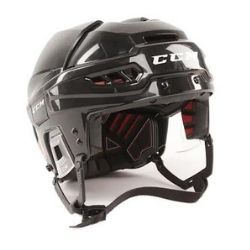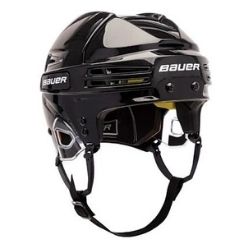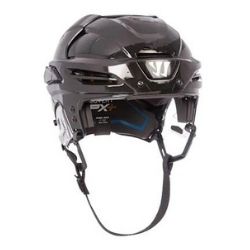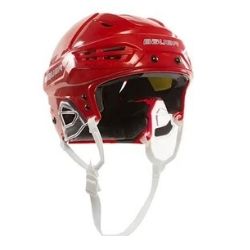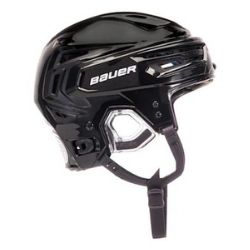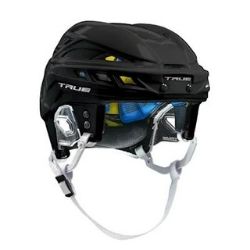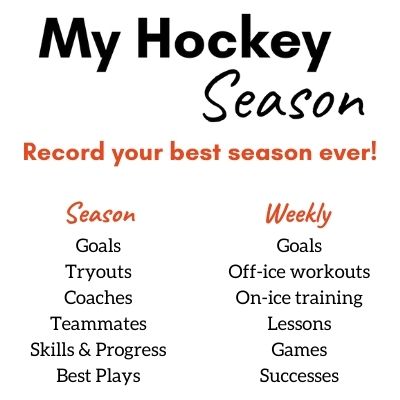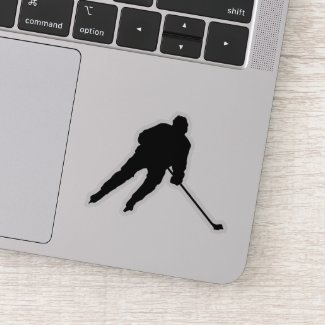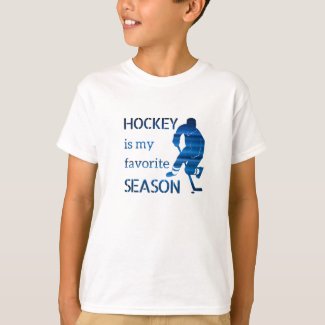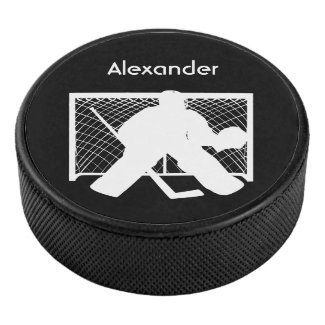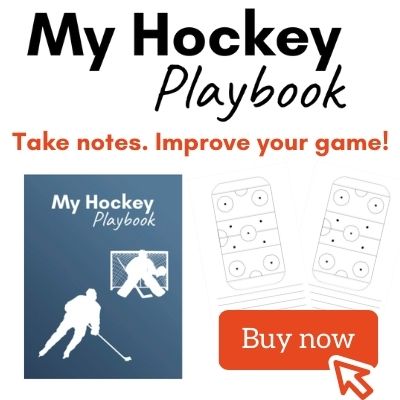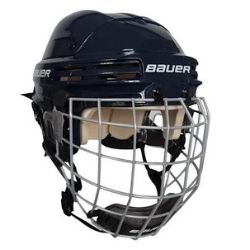The helmet is an essential part of playing ice hockey. You know it.
But in a sea of products, which one is the best hockey helmet for your needs?
Below are all my tips and selection:
- The answers to your frequently asked questions
- The 8 criteria to choose the helmet for you or your kid, easily explained
- Reviews of my selection of the best youth, junior and senior hockey helmets in 2022 - the safest, the lightest, the most comfortable...
- Tips to take care of helmets and heads
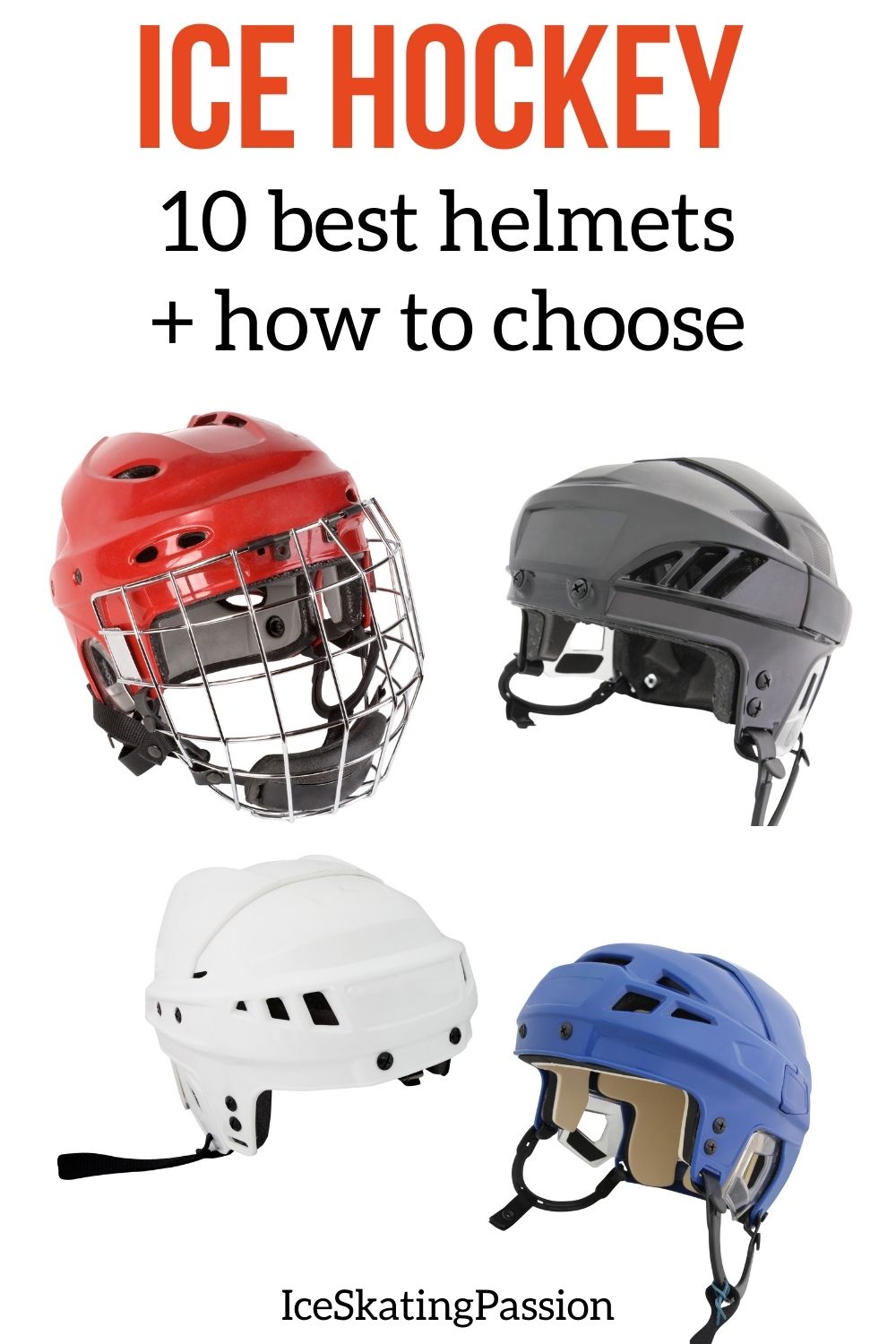
This article contains affiliate links. If you purchase using my link, I get a commission at no extra cost to you (more info here).
Best hockey helmets in 2022 - quick answer
Choosing your hockey helmet
This complete article gives your all the information your need about choosing the right hockey helmets for you. But if you don't want to read everything, below is an overview of my suggestions for youth, junior and senior players. All are, of course, certified HECC et CSA. Detailed reviews can be found further down.
All helmets are a balance of these criteria:
- protection
- safety
- comfort
- weight
- design
You have to choose what is most important to you and find the best fit for you.
4 best Youth hockey helmets
7 best Junior / Senior hockey helmets
Bauer RE-AKT 200
Best overall - Top pick
Bauer Re AKT 95
Best mid-range hockey helmet
Bauer RE AKT 150
Best for adjustability
Ice hockey helmets - Frequently Asked Questions
What are the parts of a hockey helmet?
A hockey helmet is made up of the following key components. First the fixed elements:
- Shell
The Shell is the exterior of the helmet made using plastic. It often employs a two-piece construction for a more custom fit.
The helmet is also equipped with air vents and adjustment locks. - Chin strap
On the bottom end of the shell, you will find a chin strap that must be securely fit to protect the chin and the jaw and limit unnecessary wobbling of the helmet. - Liner
The liner of the helmet adds protection value to the helmet. Basic helmets use a single-material foam liner, while advanced variants use a mix of 2-3 types of materials to protect against rotational impact using memory foams, multi-layered foam, etc.

And also optional elements:
- Cage/Visor
A cage or visor is a face protection tool that attaches to the front of the helmet. Younger players need to use a full-coverage cage while NHL players use a half-coverage visor. A cage tends to restrict vision on account of their metal bars. A visor, on the other hand, offers better clarity. Full coverage visors are also available for better protection - learn more in the criteria section - Ear guard
Earpiece that sits directly over the ears to offer the best protection. Mandatory for young players.
What is a hockey helmet made of?
Most brands such as Bauer, CCM, Warrior make the shell of a hockey helmet from a plastic-like substance called vinyl nitrile.
For the liner, various types of foam such as polypropylene foam, vinyl nitrile foam, or other plastic-based foam varieties are used.
Are hockey helmets safe? Do they prevent concussions?
The hockey helmets are constructed to protect your head and face. However, the strength of protection that a hockey helmet provides will depend entirely on the quality of its features and how well it fits you.
Concussions are caused on account of brain movement inside the skull. They occur in the event of a direct impact to the head, neck, body, or face that has the force of causing a sudden jolt to the head.
The helmet do protect the head, but no technology is advanced enough to provide guaranteed protection against concussions. Thus, even if you choose the most protective hockey helmet, you would still not be fully protected against concussions.
How often should you replace your hockey helmet? How long does a hockey helmet last?
As per the CDC, hockey helmets must be replaced within 10 years from the date of their manufacture.
However, you may need to replace it sooner, depending on the:
- change in head size (if for a growing kid...)
- type of use
- amount of use
- maintenance and care
- storage during non-use
Replace it immediately should you notice any cracks in it!
Note: the date specified on the helmet should not be misinterpreted as the expiry date of the helmet. The date specified (usually 6.5 years from the date of manufacture) is the date up to which the certification of the helmet remains valid.
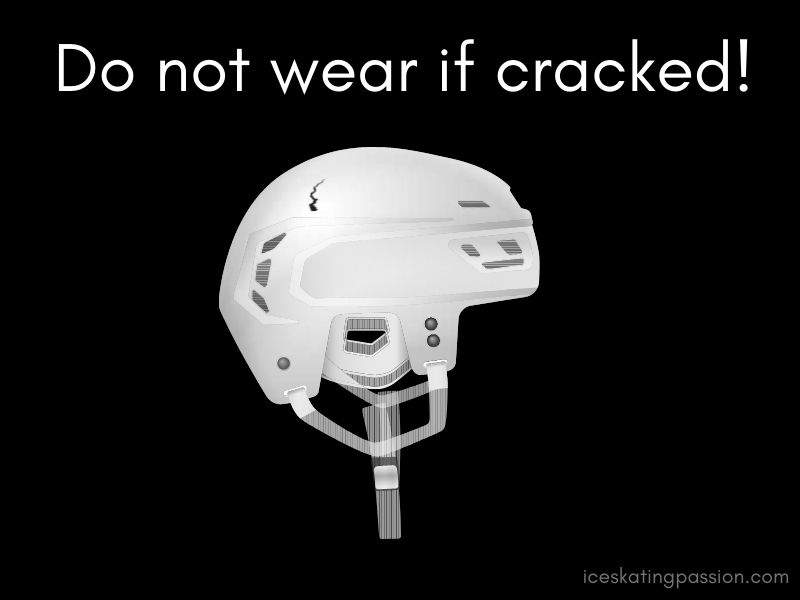
What helmets do most NHL players wear?
NHL Players were pro-level helmets from brands such as Bauer, CCM, and Warrior. The helmets use a half-coverage visor.
Additionally, all NHL players are required to abide by the rules prescribed by the league in this regard.
Should a hockey helmet cover your ears?
A hockey helmet comes with an earpiece that must sit directly over your ears to offer the best protection to your ears.
As per USA hockey rules, young players are mandatorily required to wear helmets with ear protection.
However, you will notice that a lot of NHL and adult players take the ear protection off.
8 Criteria to choose the best ice hockey helmet
#1 - Size / Fit
The safety and protection offered by a hockey helmet depend entirely on how well it fits the player.
To ensure a proper fit, it is essential to ensure the following:
- Measure the circumference of the largest part of the head, i.e., a finger above the eyebrow and just over the ears using a soft tape.
- Refer to the table below to determine the size of the helmet. Note that the table below may not apply to all the brands. It is best to reconfirm with a brand-product-specific size chart
- Open the helmet to its largest size and place it above your head.
- Adjust the helmet size using the tool-free adjustment on the sides or using screwdrivers, if required in such a way that the top end sits one finger above the eyebrow, the occipital lock on the occipital bone at the back of the head.
- Pull up the mask and fasten the chin guard in such a way that there is just about enough space to put one finger underneath.
The fit of the helmet should be snug but not too tight. Once you put on the helmet, it should not move on its own, either horizontally or vertically.
Let me reiterate that ensuring a proper fit is the only way of ensuring optimal protection. Buying a slightly larger size for growing kids can prove to be extremely dangerous.
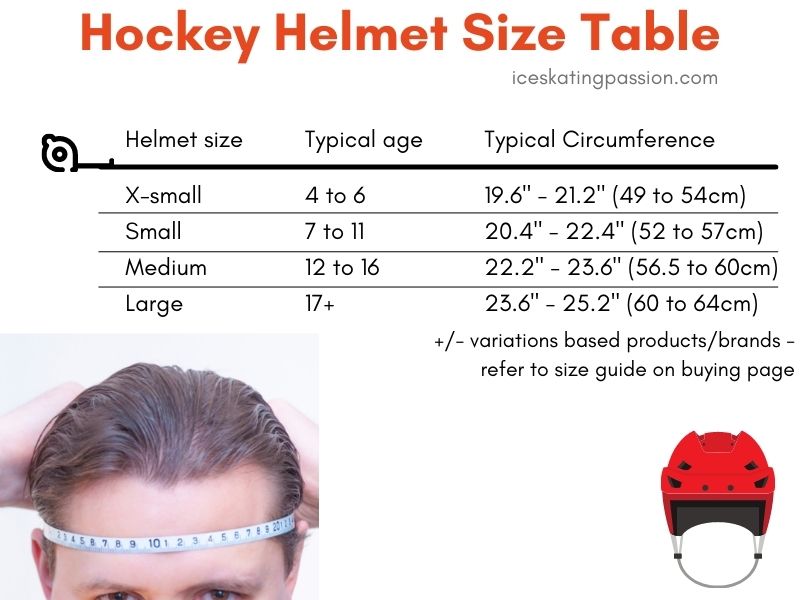
Hockey Helmet Size Table
#2 - Protection level (Certification)
Helmets are certified by CSA (Canadian Standard Association) or HECC (Hockey Equipment Certification Council). The certificate is valid for a period of 6.5 years from the date of manufacture.
Certain leagues and official tournaments prohibit players from playing if the certification on the helmets has expired.
Additionally, Virginia tech also did some testing and scored some helmets based on their level of protection. I considered their findings in my selection.
#3 - Foam lining and padding
The liner of the helmet is responsible for enhancing two factors:
- protection
- comfort
Basic helmet models use a single material foam liner made using vinyl nitrile. This padding is soft, feels more comfortable to the wearer, and allows for a more player-specific snug fit.
Advanced variants use multiple materials to provide the best protection, comfort, and fit. Multiple materials such as expanded polypropylene and dual-density foam are strategically placed around the helmet to deliver this superior performance.
Ensure that the liner used on the helmet you want to buy excels at providing adequate comfort and protection.
In addition to considering the quality of the foam, you must also look at the placement of the foam to ensure that the critical areas of the helmet, such as the temple and the back region, are sufficiently padded.
#4 - Adjustable chin strap
The chin strap is the bottom closing of the helmet. It should stay under the chin and should be snug enough to only allow a single finger under it.
Make sure you buy a helmet whose chin strap when adjusted and fastened, prevents the helmet from undue movements and wobbling.
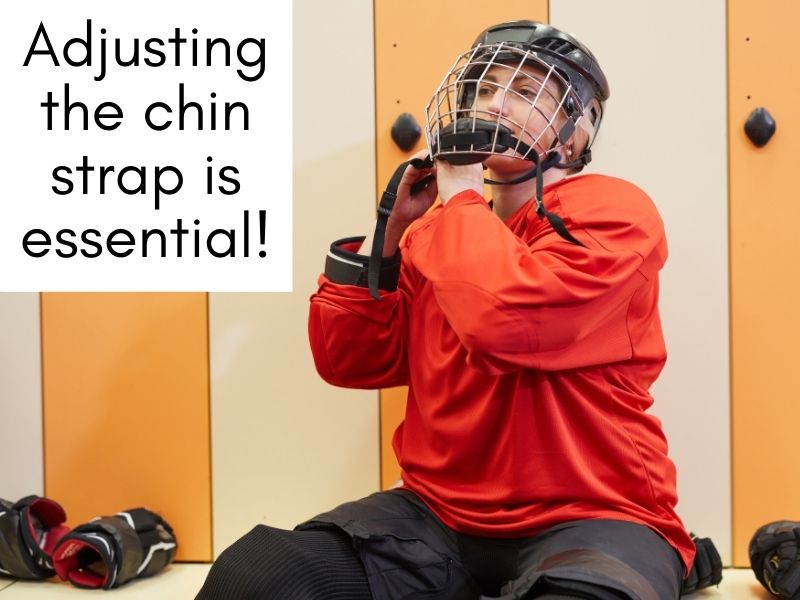
#5 - Weight
When buying a helmet, it is best to look at a helmet whose weight feels comfortable. Remember, a heavier helmet will not ensure better protection if it obstructs air circulation and causes headaches.
Similarly, a lighter helmet, although more comfortable, should not compromise on basic protection.
Thus, if opting for a lightweight helmet, check if:
- The helmet uses a high-quality lining
- The shell is strong
- The padding is adequate and strategically distributed
- The face-protection offered meets your requirements.
#6 - Presence of Cage or Visor or nothing
A helmet without a cage or visor will feel significantly more comfortable than a helmet with a cage or a visor. It will even allow better visibility and keep the face well-ventilated. However, it will expose you to a substantial risk of injury, and thus choosing to wear a helmet without a cage or a visor is not advisable.
The cage or visor is a front attachment to the helmet that is responsible for providing face protection. The key distinction between the two is as follows:
Cage:
- It offers full face protection
- Usually used by young players
- Metal bars can obstruct visibility
- It is heavier than a visor or shield
- It offers greater protection to the mouth and jaw than a visor.
Visor:
- It comes in half-face coverage or full-face coverage
- It does not obstruct visibility
- It is more lightweight than a cage
- It is susceptible to fogging
- It less protection to mouth and jaw
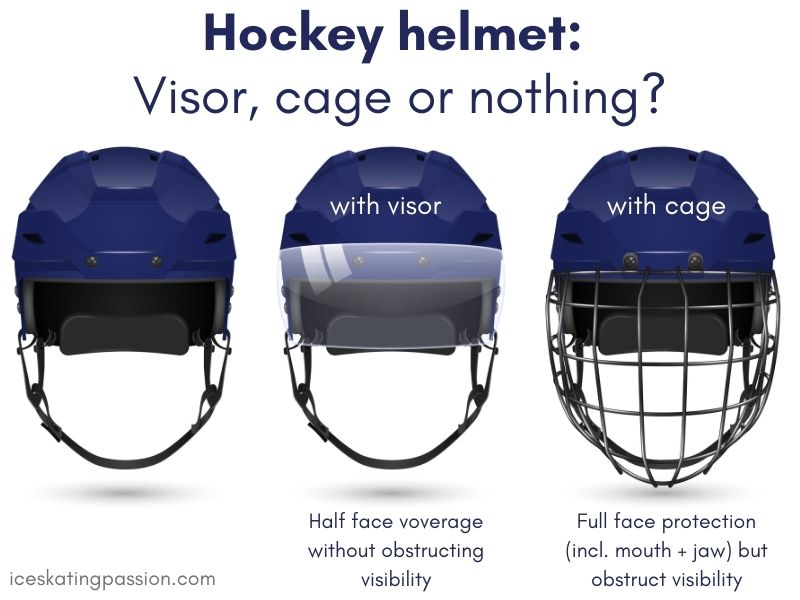
Young players are mandatorily required to use complete face protection either in the form of a cage or a shield.
Adults are free to opt for partial protection in the form of a visor.
It is important to note that the cage and visor size is often not the same as the helmet. Thus, if you are buying it separately, study the sizing chart carefully.
Alternatively, it is better to buy the helmet-cage or helmet-visor combo as it ensures proper sizing and proves to be more economical.
#7 - Design/ Style
The design or style of the helmet should be the least important factor that you consider when buying a hockey helmet. When it comes to helmets, remember that the safest hockey helmet is always the most stylish!
However, in terms of the appearance of the helmet:
- The color of the helmet should complement the rest of the gear
- The style may have to be as per the rules prescribed by your team
#8 - New vs. Used hockey helmet
You should always buy a new hockey helmet. This is because used hockey helmets, although cheaper, could come with the following risks:
- Expiry of certification
- Deterioration of padding
- Uneven padding in specific areas based on the skull shape of the previous user
- Susceptibility to cracking
Thus, to sum it up, a used helmet will put you at a greater risk of injury and hence must be avoided at all costs.
4 Best Youth Hockey Helmets - Detailed Reviews
Bauer 4500 - a classic
Pros:
- Breathable thanks to vents
- Affordable
- Excellent quality of padding used
- Adjustable with quick tool
- Comes with translucent ear protection
Cons:
- Suitable for beginner-intermediate level of play only
- People with a wider head may find it uncomfortable
Weight: 590 gms
Certifications: CSA, HECC, CE
Review:
This helmet by Bauer can easily win the crown of the best youth hockey helmet. This helmet secures a spot in this list because each of its elements is carefully designed.
- The skull is a two-piece unit, and it aligns beautifully with the natural shape of the head. It uses a dual-ridge crown that instantly feels comfortable and secure once worn. Thus, even though the fit is on the narrower end, it doesn’t feel constrictive.
- The comfort value is further enhanced by the use of dual-density foam and liner.
- The makers have also ensured that the narrow fit does not restrict the circulation of air and keeps the head cool by thoughtfully placing air channels on the helmet.
- Moreover, adjusting the helmet to the size of the head is a breeze with its easy-to-use quick adjustment tool.
Overall, this is an excellent helmet for young kids looking for a comfortable helmet that they can spend hours in.
CCM FITLITE 3DS - Best combo / budget for youth players
Pros:
- Easy-to-fit
- Youth specific cage to adjust with growing kids
- Superior back of the head protection
- Allows for change of fit when the kid grows
Cons:
- Slightly less comfortable for very round head - more for oblong.
Certifications: CSA, HECC, CE
Review:
Lots of features to be able to adjust to the head of your kid and to grow with him/her - a two-piece shell construction with a tool-less fit-adjustment system, just like to adult version used in the NHL.
Instead of using traditional snap, the velcro system on either side, allow you to set up a snug fit around your kid's chin.
You can see that is has been built specifically for youth players - the many adjustment features give parents a lot of control over how the helmet fits and protects their child.
BAUER RE-AKT combo - Best high-end / safety
Pros:
- Great level of protection
- Great quality product
Cons:
- Not many colors
- Can feel expensive for a beginner with just one practice a week
- Older model, certification will not be as long as newer model, but since kids grow, it should not be a problem
Certification - CSA, HECC, CE
Review:
A classic that has been around for a while, and is a sure value.
A focus on protection with lots of great features: Free floating liner 'Suspend-Tech', rotational Force management.
Easy to adjust.
BAUER PRODIGY - Toddler hockey helmet - beginner / budget
Pros:
- Can be worn for a few years if your kid start early
- Entry price
- Great flexibility to adapt to kids' heads
Cons:
- One size youth - only for very young child
Certifications: CSA, HECC, CE
Review:
A great introduction product for young kids just starting hockey.
- Lining with Dual density foam
- Great fit for small heads
- Good choice of colors to please your kid
7 Best junior and senior hockey helmets - reviews
Bauer RE-AKT 200 - best overall - top pick
Pros:
- Feature-rich all-round helmet
- Outstanding padding and liner quality
- Liner placement aimed to absorb rotational impacts as well
- Comes with moisture channels to keep sweat away from the eyes
- Single-lock adjustment tool and provision for custom occipital lock
Cons:
- A bit expensive
- Suitable for elite players
Certifications: CSA, HECC, CE
Review:
The Bauer Re-AKT 200 is undoubtedly the best hockey helmet available in the market today. It looks ultra-stylish and uses several advanced protective features.
- Shell - The helmet shell now uses a single lock adjustment that refines the quality of the fit. Moreover, the occipital lock can be baked for a more defined fit that significantly improves comfort and performance. The shell also uses molded side foams on the inside to prevent gaps even in the temple areas.
- Lining - the helmet has used a clever combination of hard EPP foam on the base and soft VN on the top. This makes the helmet sturdy, protective and comfortable. It also enhanced its protection by using the Bauer’s best - Poron Xrd.
- Weight / protection - The helmet makers have done an incredible job at packing a number of tough elements while continuing to keep the helmet incredibly lightweight.
- The great ventilation mechanism and moisture channels that keep sweat away from the eyes show how incredibly thoughtful the design is.
Overall, this is undoubtedly the best Junior hockey helmet or senior hockey helmet in the market.
CCM Fitlite FL500 - One of the Safest hockey helmets
Pros:
- Most protective helmet
- Best in class padding
- High-quality air ventilation technology
- Chin-cup with moisture channels for extra comfort
Cons:
- A bit expensive
- The fit may not work for all head shapes
Certifications: CSA, HECC, CE
Review:
The CCM Fitlite FL500 is the safest hockey helmet in the junior and senior category. Its solid five-star rating is also indicative of reduced concussion risk.
The formula that it applies to ensure all-round safety involves an intelligent use of a thicker VN foam liner and D30 smart foam padding. A thicker VN foam liner nullifies even the strongest of impacts with ease.
But the real game-changer is the D30 foam padding used in sensitive areas such as the occipital bone and the temples, which can take the toughest beating and instantly neutralize it. The D30 is an extraordinarily pliable material that helps keep the helmet dry and comfortable while also providing solid protection.
In addition to this, the helmet also features chin cups with moisture channels and strategically placed air vents that keep the head feeling dry and cool.
The sizing of this helmet may not work for all types of head shapes, and some people may find the body too tight on the temples and a bit loose on the back. Make sure you check the sizing chart before you order.
However, once it fits you well, you will instantly love the protection and comfort that it offers.
Face mask: Compatible with FM500 cage (must be separately bought)
Bauer RE AKT 75 - Best budget hockey helmet
Pros:
- Most value-for-money helmet for those on a budget
- Strategically placed padding for impact absorption
- Top-quality lining for impact distribution
- Effortless adjustability for a comfort fit
Cons:
- Only suitable for beginners, recreational players, and those on a budget
Certifications: CSA, HECC, CE
Review:
Of all the helmets Bauer makes, this one is probably the most impressive for how much value it packs in for its budget price tag.
- Protection - Now, given that it is a lower-end helmet, for the most part, it uses the regular multi-density foam lining. But it enhances the protectiveness of this helmet by adding signature Bauer technology in key areas. Thus it uses the Seven+ Tech on the backside, which uses plastic cylinders instead of foam for better impact absorption. The difference in quality is instantly noticeable.
Similarly, for the sensitive temple area, it uses the Poron XRD - Bauer’s most advanced padding solution. - Fit - In addition to its rich protective features, the helmet also excels in the fit department. The tool-free adjustment, like all other Bauer helmets, works seamlessly at ensuring a custom fit. The air ventilation is pretty impressive too.
Therefore, this helmet is an excellent choice for beginners or even those who are starting to get serious about the game.
Face mask: compatible with other Bauer cages
Warrior Covert PX+ - Round fit for wide head
Pros:
- Excellent value for money
- Round fit suitable for wide head
- Attractive pro-look
- Top-class lining and padding for comfort and protection
- Advanced airflow technology
Cons:
- A bit advanced for beginners or recreational players
Face mask: Krowne 2.0 cage
Certifications: CSA, HECC, CE
Review:
The Warrior Covert PX+ is an excellent helmet that is not as expensive as the Bauer Re-AKT 200 and yet packs almost the same amount of comfort and protection.
- Shape - To begin with, the distinguishing feature between this helmet and most others in the market is its round shape. This structure makes it the best hockey helmet for a wide head.
- Fit - Moreover, the tool-free adjustment works seamlessly at refining the fit both on the length and on the occipital bone.
- Lining - For the padding and lining, Warrior uses a mix of VN and EPP (i.e., soft, comfortable top and a sturdy bottom layer) similar to that of the Bauer helmet mentioned above. Even though not as sophisticated as the Bauer helmet, it does an excellent job at blocking various impacts. The protection strength is further improved by using the upgraded PX+ shell, which can easily withstand tough impacts.
However, the real highlight of this helmet is its structure and air ventilation mechanism. The player is guaranteed to experience superior comfort wearing this helmet.
Bauer Re AKT 95 - mid-range hockey helmet
Pros:
- Excellent mid-range hockey helmet
- Lightweight shell
- Top-quality padding, including padding in protection gap areas
- All-round adjustability
- Fuss-free moisture management
Cons:
- Suitable for intermediate to advanced level of play
- Not ideal for all head shapes
Certifications: CSA, HECC, CE
Review:
If you don’t have the budget to buy the Bauer Re-AKT 200 but need solid all-round protection with a lightweight, comfortable shell, this Bauer helmet is perfect for you.
- Protection - To deliver optimal protection in the mid-price range, this helmet uses a combination of foams. For the base, it uses the sturdy VTX to neutralize hard impacts, and above that, it uses a molded foam that can easily withstand low to medium impacts. The protection is further strengthened by using the Bauer premium range Poron XRD foam on the temples.
- Lining - The combined use of this lining and padding mix provides excellent stability even for modern aggressive playing. The molded foam also feels soft on the head and beautifully fills up temple gaps without feeling bulky.
- Weight - The lightweight design is also reflected in its HDPE shell. The super-light shell coupled with the strategically placed airflow vents allows plenty of air circulation. The moisture channels further contribute to the dry feel.
- Adjustability - In my opinion, the adjustment lock placed works much better than the side adjustment tools as it allows a more balanced fit. For an even more refined fit, you can even adjust the height of the helmet to align with the occipital bone using the occipital lock.
However, the helmet works better on roundish head profiles, and those with thinner head shapes could struggle to find a suitable fit.
Bauer RE AKT 150 - Best for adjustability
Pros:
- Best adjustability features
- Padding at par with other mid-range helmets
- Superior comfort thanks to its new-age liner
- Excellent impact resistance due to refined fit
Cons:
- Not as breathable as other Bauer helmets
Certifications: CSA, HECC, CE
Review:
As stated in the buying guide above, the only way a helmet serves its purpose of protection is if it fits well. That’s precisely why Bauer has gone above and beyond with the adjustability feature of this helmet.
The helmet boasts of a Freeform Adjustment System. This system lets you adjust the helmet both lengthwise and widthwise to provide you with the most defined custom fit. The adjustments work independently and do not interfere with the ear protection feature or chin strap stability.
For the protection function, the helmet uses the same combination of base and top foam as the Bauer AKT 150. Thus, it efficiently neutralizes impacts even in high-energy, aggressive play. In addition to it, it also uses a new liner called the Comfort Pod liner that works great at allowing a more comfortable yet snug fit.
What’s impressive is that the helmet, even with its snug fit, feels lightweight. Although, an upgrade on the sweat absorption mechanism would be a welcome improvement.
True Dynamic 9 Pro
Pros:
- Designed to provide reduced concussion risks
- Extremely lightweight design
- Adjustable to allow up to 5% increase or decrease in size
- Highly breathable
Cons:
- Expensive
Weight: 425 to 515 g (depending on size)
Face mask: None
Certifications: CSA, HECC
True brand hockey gear is often innovatively designed, and this helmet is no exception to it.
Unlike most other hockey helmets, this helmet does not use a two-piece shell. Instead, its one-piece shell is designed to offer excellent protection without unnecessary weight additions.
To refine the fit of the one-piece shell, the company provides interchangeable fit pads in varying thicknesses. Thus, the Fitpads can be suitably placed either on the occipital lock or on the sides based on how your head is shaped.
The helmet also allows an adjustability element of up to 5% to ensure a highly customized fit.
In terms of protection, the brand uses the MIPS Brain Protection System. This system is one-of-its-kind in the sense that it arrests rotational movement and considerably lowers concussion risks.
Additionally, this helmet is also probably the lightest hockey helmet in the market. The one-piece shell and the sturdy EPP foam thus ensure optimal protection without making the helmet feel bulky.
However, like most other True products, this product is also a bit more expensive.
4 Tips to get the most out of a hockey helmet
#1 - Regular safety check
- For young players, assess the helmet’s fit regularly and upgrade to a bigger size as soon as the need arises.
- Periodically inspect your helmet for visible damages such as cracks, missing parts, deterioration of the foam, etc. Do not try to fix the damages yourself. Always consult an expert.
- Before every session or match, check if the certification stickers have expired.
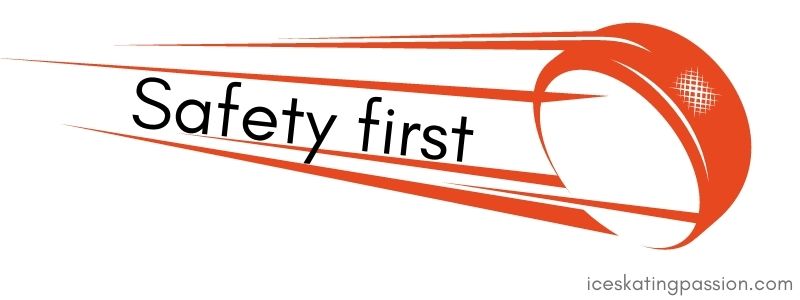
#2 - After practice care
A hockey helmet is a breeding ground of bacteria on account of how humid and sweaty it gets. Drying after each practice or game is essential:
- Take the helmet out of the bag as soon as you can.
- Always let the hockey helmet completely air dry after every use. Ideally, use a gear drying rack.
#3 - Odour control
If the helmet starts to stink, spray it with a gear deodorizer.
#4 - How to prevent skin irritation when wearing a helmet?
Skin irritation occurs on account of the friction between the head or face and the helmet. Some tips to help decrease it are:
- Wearing a helmet with appropriate air vents to allow better airflow.
- Checking for allergies and getting medically treated for the same or choosing helmets that do not trigger these allergies.
- Keeping the hair short to decrease contact of hair sweat with the forehead prevents forehead itching and acne.
Complete your hockey equipment set!
Other protective gear to get for hockey players:
- Best hockey gloves for players - read article
- Best hockey mouthguard - read article
- Best hockey shin guards - read article
- Best hockey elbow pads - read article
- Best hockey shoulder pads - read article
And if you want to work out off ice:
- 10 essential elements to cover in your off-ice workouts - read article
- 10 best off-ice hockey training equipment - read article
- Best hockey shooting pads and tiles - read article
- Best slide boards for hockey training - read article
- Best synthetic ice for hockey players - read article
- Best net targets and shooting tarps - read article
- Best hockey passers and rebounders - read article
- Best balance boards for hockey players - read article
- Best stick handling tools - read article
Share it on your favorite social media!
